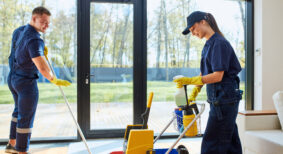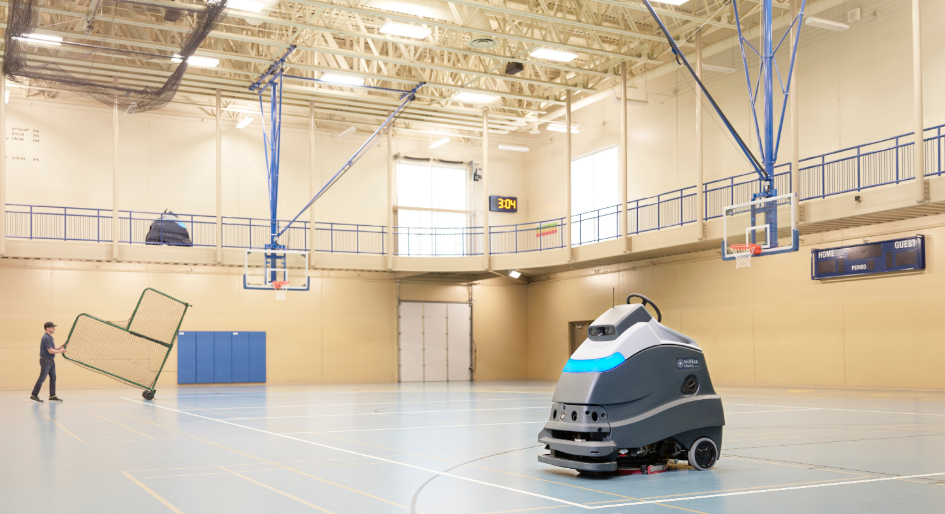Cleaning robots have gone from the wave of the future to the must-have tools of today. Companies across North America have been testing autonomous cleaning solutions for the past few years but the turning point may have been last fall, when Walmart announced it would roll out an autonomous floor scrubber at 360 of its U.S. stores.
The conditions spurring companies to seek reliable cleaning solutions with low labour requirements – growing worker shortage and ever-increasing pressure to boost productivity while cutting costs – are expected to continue, bringing major growth in the use of cleaning robots. According to a 2018 market research report, the cleaning robot market will more than double in the next few years, reaching $4.34 billion US by 2023.
No driver, no problem
Cleaning robots, or autonomous cleaning equipment, are machines that don’t require the constant attention of an operator. Although autonomous equipment is being developed for all types of cleaning, floor care equipment, particularly floor scrubbers, represent the current biggest application of the technology.
Autonomous floor scrubbers use an array of cameras, sensors and lasers, along with powerful computer processors, to perform the same functions as a ride-on scrubber, just without the operator. The most advanced machines employ intelligent navigation so that they’re able to recognize unknown obstacles in their path and provide safe use in congested spaces. Modern features include the ability to map a specific cleaning path for replicable results, cleaning flexibility without special mapping and manual mode for ad hoc cleaning.
Smart savings with A.I.
For facility managers and building service contractors, autonomous cleaning solutions provide an opportunity to save time and money on cleaning tasks. This is a major advantage for cleaning companies and their clients, as labour can account for between 55 and 90 per cent of cleaning costs. Autonomous machines can handle repetitive tasks, as much as doubling productivity, which means cleaning staff can focus on higher value activities.
Terry Zerwas, director of buildings and grounds for the St. Michael-Albertville School District in Minnesota, has found their autonomous floor scrubber has saved significant labour hours each day.
Walmart predicts its machines will save two hours of employee time per location, per day.
As the technology advances and more robots become available, the potential savings will multiply. Industry experts estimate 40 per cent of the total professional cleaning market could eventually use autonomous solutions.
Cleaning robots can also provide a level of quality and consistency that human operators often struggle to achieve. Once a machine is programmed for a cleaning path, it will follow that exact path every time, adjusting for obstacles when necessary, which guarantees replication perfection. The equipment can also be set to automatically adjust water and detergent levels to reduce chemical usage and help companies achieve sustainability goals.
Cleaning robots also enhance the health and safety of cleaning staff by eliminating the ergonomic challenges associated with some manual equipment, as well as the risk of repetitive stress injuries.
Learning to love robots
Integrating autonomous equipment into the cleaning process requires careful planning and execution, and because the technology is so new, it may take some extra time to become accustomed to. However, there are three things that will go a long way to helping ensure a seamless transition.
First, use state-of-the-art equipment. Most major cleaning equipment manufacturers have autonomous solutions available but they’re not all created equal. Features to look for include: flexibility of use; advanced sensing and navigation technology, which provides high-quality cleaning in challenging areas, such as around obstacles and close to walls and corners; an intuitive interface (required for employees’ acceptance of the machines); and operational data collection and management that companies can leverage to analyze and optimize their cleaning capabilities.
Next, assure cleaning staff that the robots aren’t there to take their jobs. One of the fears many people have surrounding any type of automation is that their roles will become redundant. In the case of cleaning equipment, this is typically not true. Most cleaning companies are understaffed or have trouble retaining employees, and their goal in adopting autonomous machines is to enhance, not replace, their current workforce. In fact, robots can improve human cleaning technicians’ job satisfaction by taking over the most boring, repetitive tasks.
Last, but certainly not least, provide training. Autonomous solutions don’t need a lot of training since operators aren’t required for use. But there are some functions, like defining a cleaning path, that do rely on operator input, at least at the beginning. For machines that can also be used in manual mode, training is needed for ad hoc cleaning tasks.
Matt Fussy is director of product management, connected autonomous solutions, at Nilfisk, a supplier of professional cleaning equipment in the industrial, commercial and consumer markets.








